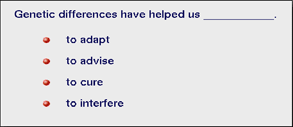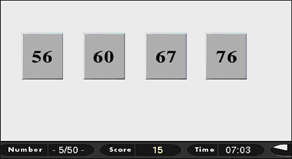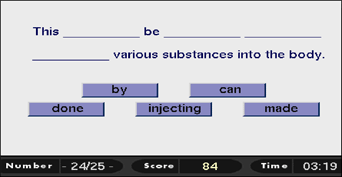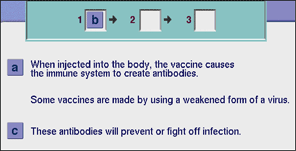DynEd's Mastery Tests are computer-assisted achievement tests designed to evaluate student progress and confirm mastery of the language skills developed in each course. Access to the tests is controlled by the teacher or administrator through the Records Manager. Each test takes from six to twelve minutes, and consists of between 20 and 50 test items.
Test items are randomly selected from a database of test items to ensure variation for each learner and from one test session to another.
Mastery Test scores are automatically recorded in the Study Records. The best possible score for each test is always 100. Generally, a score of 80 or more is necessary to indicate that a student has studied the lessons sufficiently so that long-term learning can occur. For students who score less than 80, more study is advisable. Since the test items are taken directly from the lessons, students who have studied and reviewed the lessons with any sustained effort should be able to score at least 80 within the allotted time, provided they have reasonable reading and motor skills. Generally the class average for a test should be 90 or greater. For grading purposes the scores might translate as follows:
| 96-100 | = A or Excellent | 90-95 | = B or Good |
| 85-89 | = C or Satisfactory | 80-84 | = D or Unsatisfactory Pass |
| 0-79 | = F or Not Pass |
When to Take a Test
Students should take a Mastery Test when they (or the teacher) feel they have sufficiently mastered the language in a unit. For most students this is generally when their Completion Percentage is above 85 for each lesson in the unit to be tested. Of course, this varies according to the student's initial level and linguistic background.
Once the teacher decides to have students take a Mastery Test, the teacher must use the Records Manager to unlock (grant access to) the particular test for the unit to be tested. Generally, tests will automatically re-lock once they have been taken.
Test results for each student will be found in the Records Manager, within the study records of the unit which was tested. Students can also see their test scores in their own Student Records, which they can view at anytime when they are in the course.
Types of Test Questions
There are several types of questions in each Mastery Test, ranging from multiple-choice, listening comprehension questions, to sentence construction items which require click and drag manipulation.
Lexical/Grammatical
This multiple choice type of question generally focuses on vocabulary or grammar points, such as which form of a verb to use. Students read a sentence and then indicate which of four choices correctly completes the sentence.
These questions are timed, and students have two chances to answer them. If students get the correct answer on their first try, they get a full score. If they get the correct answer on their second try, they get a partial score. The cumulative score is shown at the bottom of the test screen.

Listening Comprehension
A second type of question focuses on listening comprehension. For example, the student may hear a question or statement and have to answer or complete it with the correct choice.
In these types of questions, the student has only one chance to get the correct answer. If the answer is correct, the program will repeat the answer or give a rejoinder and go on. If the answer is incorrect, the program will indicate that it is wrong and then go on to the next question.
If a question times out, the question will be repeated once. If the question times out a second time, the program will move on to the next question.


Sentence Construction
In the third type of test item, students are asked to move a set of words into the correct places within a sentence. Though these tasks are difficult for someone who hasn't studied the lesson, in every case the sentences come directly from the lesson and will be familiar to students who have spent sufficient time in the unit. In fact, many of these questions come directly from the Focus Exercise lessons.
In this type of test item, students have two chances to complete a sentence. If they are correct on their first attempt, they get full credit. If they are correct on their second attempt, they get partial credit. Students are also allowed to time out once before the program moves on to the next item.

Sentence Ordering
In selected DynEd products, the Mastery Tests have sentence-ordering items. These come directly from the lessons, and should therefore be familiar to all students who have studied in depth the lessons from those units.
In these items, students should read the sentences and then decide the order. In this example (see below), sentence B comes first, followed by A and C.
These items test a student's ability to see how items within one sentence refer to items in other sentences.

Copyright © 2024 DynEd International, Inc. All rights reserved
Apple, iPad, iPhone, iPod touch, and iTunes are trademarks of Apple Inc., registered in the U.S. and other countries. App Store is a service mark of Apple Inc.
Windows is a registered trademark of Microsoft Corporation in the United States and other countries.
Android and Google Play are trademarks of Google Inc. The Android robot is reproduced or modified from work created and shared by Google and used according to terms described in the Creative Commons 3.0 Attribution License.
BlackBerry is a registered trademark of Research in Motion Limited. BlackBerry World is a trademark of Research in Motion Limited.

